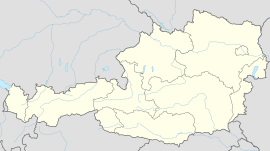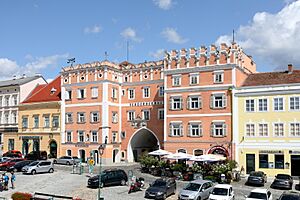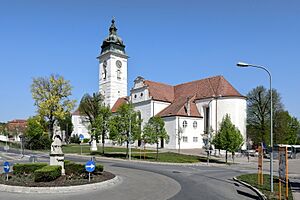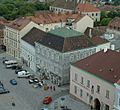Retz facts for kids
Quick facts for kids
Retz
|
||
|---|---|---|
|
Municipality
|
||
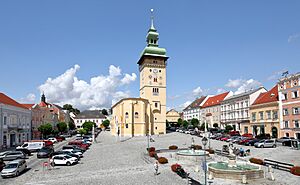
Main square of Retz
|
||
|
||
| Country | Austria | |
| State | Lower Austria | |
| District | Hollabrunn | |
| Area | ||
| • Total | 45.02 km2 (17.38 sq mi) | |
| Elevation | 252 m (827 ft) | |
| Time zone | UTC+1 (CET) | |
| • Summer (DST) | UTC+2 (CEST) | |
| Postal code |
2070
|
|
| Area code | 02942 | |
| Vehicle registration | HL | |
| Website | www.retz.at | |
Retz is a charming town located in the Hollabrunn District of Lower Austria, a state in Austria. It's known for its rich history, beautiful buildings, and especially its wine. About 4,168 people live in Retz, making it a lively community with a lot to explore.
Contents
Discovering Retz: Geography and Location
Retz is found in the northwestern part of the Weinviertel region in Lower Austria. This area is famous for its vineyards and rolling hills.
The town covers an area of about 45 square kilometers (17.4 square miles). A small part of this land, about 11.83 percent, is covered by forests.
The municipality of Retz includes several smaller areas called cadastral municipalities. These are Hofern, Kleinhöflein, Kleinriedenthal, Obernalb, Retz, and Unternalb.
A Journey Through Time: The History of Retz
The story of Retz began a long time ago, with a small village forming near what is now the main meadow. This village was first mentioned in the year 1180 and was called "Rezze," which means "small creek" in Slavic.
The Middle Ages: Founding and Challenges
Around the year 1300, Count Berthold of Rabenswalde decided to build the city of Retz. He also founded a monastery for the Dominican Order, which was completed in 1295.
A famous preacher named Franz von Retz was born around 1343. He became an important figure in the Dominican Order and taught at the University of Vienna. He was even the university's Dean five times!
In 1425, Retz faced a big challenge when the Hussites, a group from Bohemia, attacked and destroyed the city. Many people were killed or taken captive. The Hussites raided Retz again in 1431.
After being rebuilt, Retz was taken over by King Matthias Corvinus in 1486 after a six-day siege. Retz was part of his kingdom until 1492. During this time, the city received special rights for trading wine. These rights helped Retz become very wealthy. Because of this, a huge system of multi-story wine cellars was built. Today, you can take tours of these cellars, and they even host a Christmas market!
16th and 17th Centuries: Growth and Hardship
From 1568 to 1569, the old church on the main square was turned into the city's town hall. A special chapel called the Marienkapelle was built on the first floor.
In 1576, the beautiful Sgraffitohaus was built. Its unique painted designs, called sgraffito, were hidden for many years but were rediscovered and restored in 1928.
Another eye-catching building is the Verderberhaus, built in 1583. It's named after the wealthy Verderber family who owned it.
The Thirty Years' War in the 17th century brought more destruction to Retz. Later, in 1680, the terrible bubonic plague affected the town. The Pestsäule (Plague Column) on the main square still reminds people of this difficult time.
18th and 19th Centuries: New Landmarks and Connections
The spire of the Parish Church of Saint Stephen was beautifully redone in the baroque style between 1701 and 1713. The whole church was later enlarged and rebuilt in the baroque style from 1721 to 1728.
The first windmill in Retz was built entirely of wood in 1772. Later, a stone windmill was built nearby. This stone windmill is now a house.
In 1831, a new wooden windmill was built in the same spot. This windmill is still standing today and is special because it's the only fully working windmill left in Austria! Not far from the windmill, you can find the Kalvarienberg, a religious sculpture group built between 1727 and 1737.
On November 1, 1871, Retz became connected to the international railway system. This made it easier for people and goods to travel to and from the town.
Main Sights: What to See in Retz
Retz has many interesting places to visit, showing its long history and unique culture.
Historical Buildings and Landmarks
- Hauptplatz (Main Square): This central square is home to the Pranger (a historic pillory), the town hall, the Verderberhaus, and the Sgraffitohaus. Below the square is a huge system of wine cellars.
- Gatterburg Castle: A historic castle that now houses a museum.
- Dominikanerkirche and Monastery: The beautiful Dominican church and its monastery.
- Parish Church Saint Stephen: A large and impressive church with a baroque design.
- Windmill of Retz: The only fully functional windmill in Austria, a true landmark.
- Calvary: A religious sculpture site near the windmill.
- Military Cemetery: Built in 1979, this cemetery is where German soldiers who died in the Weinviertel region are buried.
Museums to Explore
- Fahrradmuseum (Bicycle Museum): Located at Gatterburg Castle, this museum showcases the history of bicycles.
- Retzer Erlebniskeller ("Adventure Wine Cellar"): One of the largest cellar systems in Mitteleuropa (Central Europe), offering an exciting journey through the world of wine.
- Museum Retz: This museum tells the story of local history and features a gallery of art from the South Moravian area.
Events: Festivals and Celebrations
Retz hosts several fun events throughout the year that celebrate its traditions and products.
- Weintage ("Wine Days"): An annual 10-day festival that starts around the time of Corpus Christi, celebrating the region's famous wines.
- Weinlesefest ("Grape Harvest Festival"): Held annually on the last weekend of September, this festival celebrates the grape harvest season.
- Kürbisfest im Retzer Land ("Pumpkin Festival"): A lively festival in the region around Retz that celebrates pumpkins.
Economy and Infrastructure: Life in Retz
Retz has always been a city known for trade, especially for its wine. The town's economy relies on both traditional businesses and agriculture.
Transportation: Getting Around
Retz is well-connected by train. It has a station on the Nordwestbahn line, with regular trains to Vienna, the capital of Austria, and also to Znojmo in the Czech Republic.
Population Growth: How Retz Has Changed
In 2001, Retz had 4,168 inhabitants. The population has seen some changes over the years. For example, in 1991, there were 4,284 people, and in 1971, there were 4,927.
Images for kids
See also
 In Spanish: Retz (Austria) para niños
In Spanish: Retz (Austria) para niños



